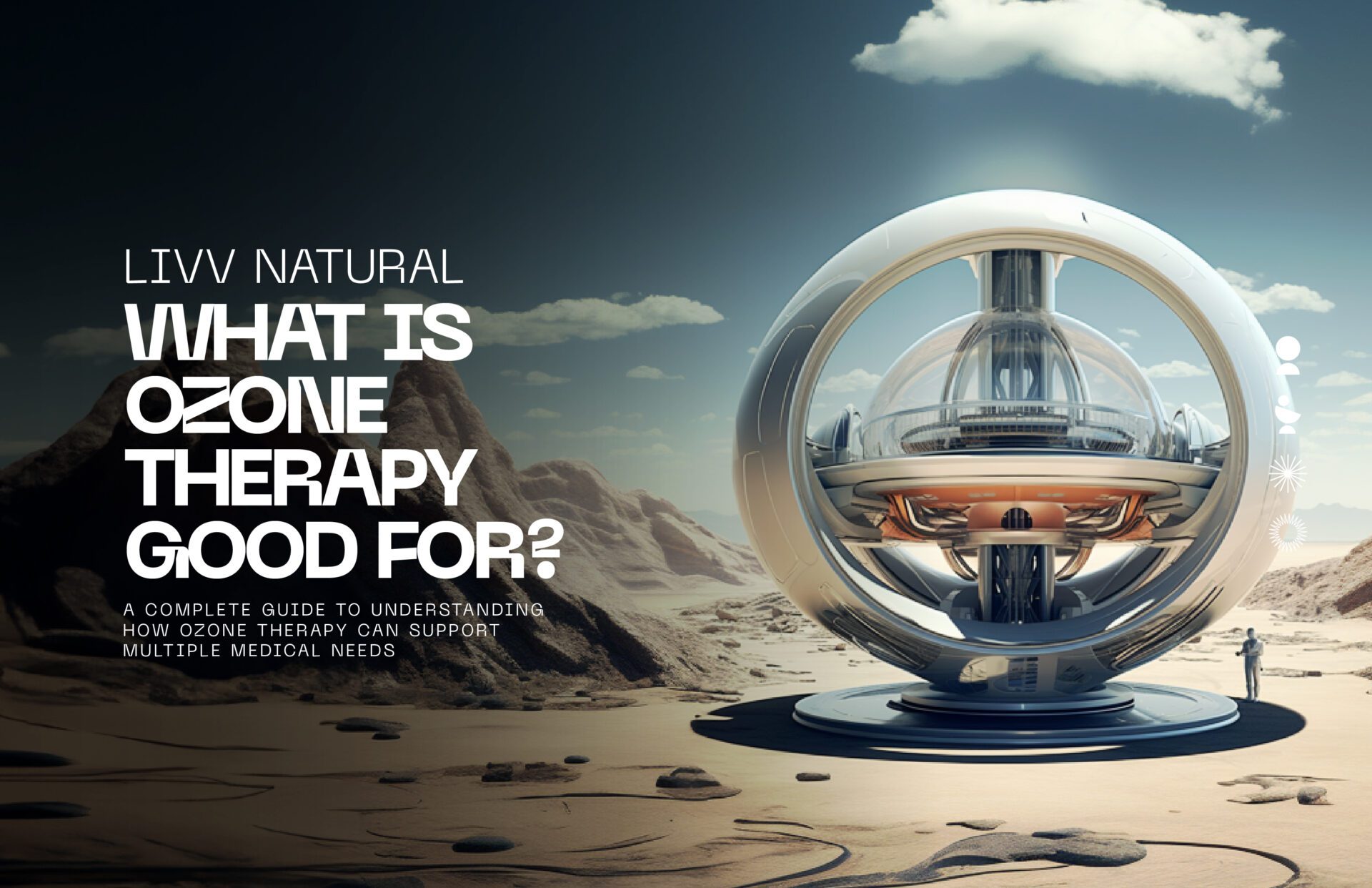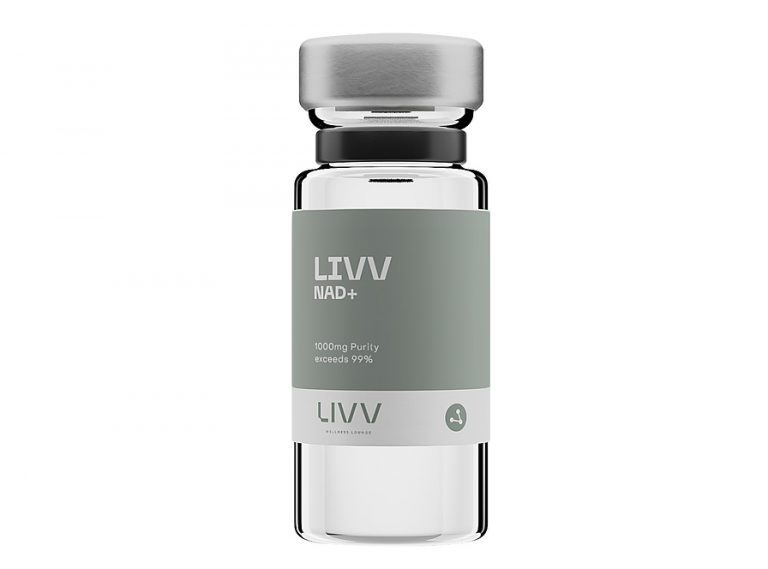What is Ozone and what is it good for?

Contents
What is ozone?
What is ozone therapy?
Ozone therapy benefits
Are there risks to ozone therapy?
Does ozone therapy work?
Is ozone therapy safe?
Safe and effective ozone treatments at LIVV Natural
What is ozone therapy? People have used this form of treatment to combat pain and disease for around 150 years. Studies have found several uses for ozone treatment. Researchers say it activates the immune system and disinfects wounds.
Discover where ozone comes from in our comprehensive guide. We explain the benefits and possible risks of this pale blue gas. Read on to find out if this intriguing treatment is safe, how it works, and whether it has a future in medicine.
What is ozone?
Ozone (O₃) is a molecular form of oxygen, boasting three atoms instead of two. As a solid or liquid, ozone is highly unstable, but it may hold holistic benefits in gas form.
The gas compound occurs naturally in the atmosphere, but it’s also man made. It impacts life on earth in positive and negative ways.
This pale blue gas has a noticeable aroma like chlorine. Many people can smell it after electrical storms. Atmospheric ozone forms when ultraviolet rays interact with molecular oxygen (O₂).
Most people know about the ozone layer, about 6–30 miles above the ground. It straddles the stratosphere and prevents most harmful radiation from reaching us. The ground would be sterile and incapable of hosting life without the ozone layer.
Ozone also forms at ground level. Two kinds of pollutants interact to form low-altitude ozone. Volatile organic compounds and nitrogen oxides react to form the gas.
What is ozone therapy?
What is ozone therapy? This alternative practice uses medical-grade ozone gas to treat injuries, wounds, and illnesses. The goal is to increase the amount of oxygen in the body.
There are various types of ozone therapy. Trained technicians typically administer ozone directly into the bloodstream or via ozone insufflation. The best ozone treatment options vary depending on your needs.
Treatments also include ozonated oils for topical use. Ozone saunas involve bagging a body part and exposing it to the gas. In autohemotherapy, doctors extract blood to mix it with saline and medical ozone gas. Then, they return it to the bloodstream with an IV.
Some doctors provide ozone injections for:
- Disc herniations
- Sports injuries
- Muscle or joint discomfort
- Back or neck pain
- Arthritis
Ozone therapy presents pro-oxidative effects that can inactivate organisms, like bacteria and viruses. The gas boosts oxygenation and may give the immune system a lift. Researchers are investigating the efficacy of these treatments in scientific trials.
Ozone therapy benefits
There are several reported ozone therapy benefits. Long used to combat pain, doctors have found an array of other applications in the past few decades. They use this versatile therapy to treat:
- Infections or wounds
- HIV/AIDS
- Lyme disease
- Fibromyalgia
- SARS
- Diabetic ulcers
- Arthritis and rheumatism
- Viral illnesses
- Circulation issues
- Cancer
Ozone treatments provide many positives. We assess the most significant benefits below.
Boosts immune system
Some trials link ozone therapy to reduced levels of inflammation. Pain and discomfort can indicate oxidative stress, which is typically caused by an imbalance of antioxidants and free radicals.
Ozone treatment may help you manage the symptoms of arthritis and Crohn’s disease. The gas may even heal damage from long-term chronic inflammation.
If your immune system is sturdy, it can fight off infections decisively. Ozone therapy boosts the amount of oxygen in your body, speeding up cell regeneration.
Antiviral, antibacterial, and antifungal properties
Ozone inhibits viral replication and inactivates viruses. Several trials found it could help combat COVID-19 and fight the spread of seasonal flu. One investigation found it successfully treated Epstein-Barr Virus (EBV) and HSV.
It reportedly detoxes the body and halts infections. Ozone might help when bacteria become resistant to antibiotics. Topical ozonated oils could treat ulcers, dermatitis, or fungal infections.
Heals wounds
Some people use ozone as an antimicrobial topical treatment. There’s overwhelming evidence that controlled exposure can reduce bacterial load in wounds. Several trials assess how gaseous ozone exposure can treat infected wounds.
High concentrations of ozone can be dangerous. It can cause irreversible side effects, damaging crucial parts of cell biology. Careful dosing makes it a viable treatment for necrotizing skin infections. It could also combat allergies and speed up healing.
Relieves pain
A 2017 trial found ozone therapy more effective than medication. It indicates ozone reduces inflammation and treats pain from joint disease. Researchers think it may also spur new cartilage growth.
A 2022 study suggests ozone treatments may help with back pain, osteoarthritis, and rheumatic diseases. It found a clear interaction with the inflammatory pathway. It has potential for treating chronic inflammation or immune over-activation.
Cell oxygenation
The idea of ozone therapy is to increase the levels of oxygen in the body. It boosts the immune system and promotes cell regeneration. It speeds up healing by repairing or replacing the damaged cells of a wound.
Cells and tissues can die if they don’t get enough oxygen. Increased oxygen levels allow them to recover and repair quickly. Antioxidant effects elevate elastin and collagen production to create new, healthy skin.
Strengthens the respiratory system
A 2020 medical trial found reduced recovery time from COVID-19 with ozone treatments. Lung disinfection methods responded faster and patients tested negative more rapidly. Fewer progressed to pneumonia.
Another trial recommends ozone therapy to combat pneumonia, especially in the early stages. It’s shown to counter the effects of COVID-19 on lung tissues.
Improves circulatory system
Ozone therapy benefits blood circulation and oxygen delivery to tissues. Studies show insufflation could be a complementary therapy for treating coronary artery disease. It activates the antioxidant system and reduces oxidative stress markers.
Fatty plaque builds up in the arteries with age. It’s difficult for blood to push through, elevating the risk of deep vein thrombosis (DVT). People over 40 are more susceptible, and obesity increases the chances.
Ozone therapy can clear out the plaque from arteries and veins. It strengthens arterial walls and neutralizes toxins in your blood. It reduces blood pressure and the potential for heart attacks or strokes.
Improves brain function
Ozone can cross the blood-brain barrier, stimulating anti neuroinflammatory effects in your brain. The gas could slow neurodegenerative diseases, like Alzheimer’s and dementia.
Ozone therapy can increase oxygen utilization by brain cells. It can fight brain fog and improve concentration and memory. Some claim ozone bath treatments boost mental clarity and cognitive performance.
A 2012 study combined ozone and oxygen to see if it could prevent further brain tissue damage. Research shows it may help reset the brain or revert it to its original state after a stroke.
Reduces risk of repeat heart attacks
Ozone treatment may reduce the potential of a second heart attack in patients who’ve already had one. Ozone limits the development of dead tissue due to a lack of oxygen. It also reduces the chance of heart arrhythmia (irregular heartbeat).
Other benefits
Here are some more ozone therapy benefits:
- Body detoxification. Ozone speeds up metabolism, allowing your body to fight environmental toxins and diseases.
- Stem cell repair. Stem cells are vital to repairing your organs. Ozone therapy can help these crucial cells reactivate and quickly fix damaged tissue.
- Better joint mobility. Ozone can improve joint mobility by elevating oxygen levels in the blood. It fights against musculoskeletal conditions like bursitis, rheumatoid arthritis, and carpal tunnel syndrome.
Are there risks to ozone therapy?
There are a few potential side effects from ozone treatments.
Ensure you approach accomplished professionals for the best results. Experienced practitioners can minimize side effects with practical and theoretical preparation. LIVV Natural has some of the finest licensed naturopathic doctors in the USA.
Side effects could include:
- Embolism. An air bubble could form during intravenous ozone therapy. It’s rare, but it can block an artery or vein, potentially causing a stroke or heart attack.
- Cramping. Ozone insufflation may cause temporary discomfort or cramping. It typically happens from rectal introduction of the gas and soon passes.
- Skin reactions. A few people have a minor allergic reaction to topical ozone treatments. The skin gets irritated with effects similar to “nettle rash.”
- Herxheimer reaction. Some people experience flu symptoms and feel worse in the short term. It’s a transient immune response triggered by a heightened prevalence of endotoxins.
Does ozone therapy work?
Ozone treatments are still classified as unregulated alternative medical procedures. Some say they’re controversial, while others argue ozone therapy benefits many people.
This form of treatment has been used for decades. Many studies show ozone therapy offers safe, consistent results with minimal side effects.
Many dentists use ozonated water, usually as a spray. It can reduce or even stop tooth decay, promoting oral health. Doctors use ozone for infected wounds and various viral or neurodegenerative diseases. Others claim it helps with macular degeneration and arthritis.
Is ozone therapy safe?
Ozone therapy is not yet approved by the FDA. A 2019 statement advised against it, stating ozone is a toxic gas with no known medicinal uses. While some reports state the gas is safe, others conclude there’s insufficient data.
Recorded side effects include pulmonary embolism, blood-borne infections, and bilateral vision loss. High doses and extended treatment regimens may exacerbate the hazards.
At LIVV Natural, our highly trained therapists know how to apply ozone therapy. Prudent doses always relate to the antioxidant capacity of tissues and body fluids. It excludes the cytotoxic and mutagenic potential.
Treatments that target infections can produce a temporary reaction connected. It can cause muscle pain, fever, chills, elevated heart rate, and blood pressure.
Ozone treatments should never involve inhaling the gas, as it’s toxic to humans. The gas irritates the respiratory system and burns the eyes, nose, and throat. It can cause headaches, coughing, nausea, and vomiting.
Short-term inhalation can cause a dangerous build-up of fluid and lung damage. Extended exposure can be fatal. It also displays toxic effects when it combines with nitrogen oxide in smog.
Safe and effective ozone treatments at LIVV Natural
Researchers need to perform further trials to determine the efficacy of ozone treatments. The existing data shows there may be many ozone therapy benefits. It could boost the immune system, heal wounds, improve brain function, and relieve pain, to name a few.
Contact us to book an appointment with our licensed naturopathic doctors. We offer safe and effective ozone treatments under the guidance of an experienced professional.
Author: Dr. Jason Phan NMD – Founder of LIVV Natural – Anti-aging – regenerative medicine – peptide therapy


